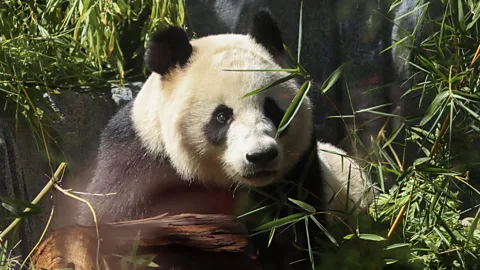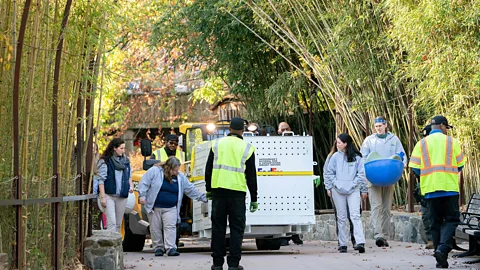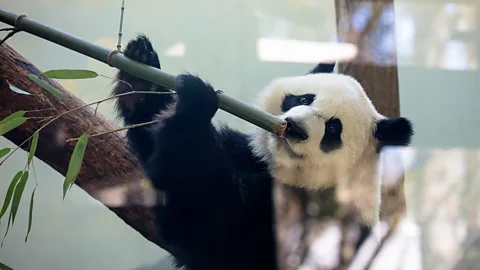A brief history of 'panda diplomacy' - with new additions to global zoos
 Getty Images
Getty ImagesWith the latest panda additions to the San Diego Zoo, 'panda diplomacy' is back in the vernacular. Here's what it means and why it's so important.
After a month and a half of settling into their new home at San Diego Zoo, two giant pandas – Yun Chuan and Xin Bao – are receiving their first visits from the public.
Their arrival in the United States at the end of June 2024 marked the latest twist in China's use of its charismatic, bamboo-munching black-and-white bears as part of its international relations.
This "panda diplomacy" has a long history, that dates perhaps as far as the Tang Dynasty, which ruled from 618 through 907 CE. The movement of the animals around the world offers some insights into the ebb and flow of China's relationships with other nations.
The arrival of Yun Chuan and Zin Bao follows the recent recall of three giant pandas that had been living at the National Zoo in Washington DC and one living at the Memphis Zoo in Tennessee. Until June 2024, it left only four pandas in the US, all at the zoo in Atlanta, Georgia. Similarly, in the UK, two giant pandas that had lived at Edinburgh Zoo since 2011 were recalled in 2023.
Those decisions arrived at a time when relations between Beijing and the West reached a particularly rocky phase. China and the US, for example, were navigating some decidedly tense security, humanitarian and economic challenges, according to an article about animal diplomacy from Georgetown University's Barbara Bodine, a distinguished professor of diplomacy and director of Georgetown's Institute for the Study of Diplomacy.
Following the agreement to send the pandas to San Diego Zoo, Chinese Premier Li Qiang also offered to send pandas to Australia as the two countries restored relations following a diplomatic dispute over agricultural and mineral exports.
The renewed flurry of panda diplomacy may be part of China’s pursuit of "soft power", explains Susan Brownell, a professor of anthropology at the University of Missouri-St. Louis and a member of the National Committee on US-China Relations, which works to promote understanding and cooperation between the two countries. Researchers at the University of Oxford have even gone so far as to chart the trajectory of China's "soft cuddly power" through its use of pandas in an academic paper published in 2013.
 Getty Images
Getty ImagesThe history of panda diplomacy
Since it was founded in 1949, the People's Republic of China has used giant pandas as a gesture of goodwill towards its international allies and competitors.
The animals are native to the high, bamboo-covered mountain slopes in south-central China but now only exist in the wild in six isolated valleys within protected nature reserves, where their numbers have dwindled to just 33 populations.
Chinese Communist Party leader Mao Zedong sent his first "panda ambassadors" as gifts to the Soviet Union in 1957 when he gifted the Ping Ping and Qi Qi to the USSR to mark the 40th anniversary of the October Revolution in Russia. He also gifted pandas to other socialist allies such as North Korea, in an effort to strengthen ties.
A major diplomatic milestone was reached, however, in 1972 – just two months after US President Richard Nixon made his historic journey to China in an attempt to end more than two decades of frosty relations between the two countries – when an 18-month-old pair of pandas arrived in the US as a gift. The pair, named Hsing-Hsing and Ling Ling, remained in the US until they died. Ling Ling suffered heart failure in 1992. while Hsing-Hising lived to be 28 years old before he was put to sleep due to failing health in 1999.
But Hsing-Hsing and Ling Ling were far from the first pandas to be gifted to the US. In 1941, two pandas were sent to the US as a "thank you" gift from China by Chiang Kai-Shek for assisting Chinese refugees during the country's war with Japan.
It wasn't until 1972 that China gifted Japan two pandas – Kang Kang and Lan Lan – when the two countries normalised diplomatic ties. Then in 1984 the "gifts" changed to "loans" where zoos would pay substantial fees towards panda conservation projects in China. It can cost zoos up to $1m (£790,000) a year to host a pair of pandas, plus the costs of housing the animals, keeping them in fresh bamboo and in good health.
More recently, panda loan deals have coincided with lucrative trade agreements – something the Oxford University academics associated with the Chinese concept of "guanxi", which is the development of deep relationships and networks of influence built on trust, loyalty and reciprocity.
Australia, for example, was loaned pandas in 2009, while Canada and France received pandas in 2012. The timing appeared to coincide follow lucrative uranium deals and contracts between China and these countries, suggests Kathleen Buckingham and colleagues at the Oxford University in their paper. The loan of two pandas – Tian Tian and Yang Guang – to Edinburgh Zoo in Scotland was agreed during negotiations over contracts to supply salmon meat, Land Rover vehicles and energy technology to China.
This flurry of panda loans followed the devastating earthquake in 2008 in China's Sichuan Province, which badly damaged the Wolong Nature Reserve and Breeding Centre, meaning the animals living there needed to be rehomed.
 Getty Images
Getty ImagesBut there are still examples where pandas are used as a way of repairing strains between China and its global neighbours. Following the March 2014 disappearance of Malaysian Airlines Flight 370, relations between China and Malaysia became fraught. The arrival of two pandas that same year in Malaysia was seen as a peace offering.
China also seems happy to use its pandas to signal displeasure too – what it gives, it can take away. In 2010, two US-born panda cubs were on an aircraft back to China two days after Chinese officials warned President Barack Obama ahead of a planned meeting between Obama and the Dalia Lama that they could take "corresponding action". The pandas were due to be returned to China two years earlier but stayed in the US due to their popularity with visitors.
The arrival of San Diego's new pandas – Yun Chuan and Xin Bao – makes them the first of the Chinese bears to enter the US in 21 years. They are expected to be followed by another pair of two-year-old pandas – Bao Li and Qing Bao – who are to be housed at the Smithsonian's National Zoo in Washington DC, around a year after the zoo returned three of its pandas to China. The loan agreement formed part of a 10-year research and breeding cooperation agreement.
As for what the pandas may be promising today, Brownell suggests China is hoping to broaden its influence around the world. "They know very well that their growing economic and military strength is viewed as a threat, particularly by the political leadership of the US," says Brownell. "They also understand that a big factor [of US] influence in the world comes from the appeal of its cultural products, whether it's Hollywood movies or NBA stars.
"Their use of the lovable pandas, as well as the state promotion of Olympic sports, is part of their effort to develop that kind of appeal and influence in the world."
San Diego's new pandas
San Diego Zoo's newest residents will be in the US for 10 years under the loan agreement, which will help to support conservation breeding efforts in China. The male – Yun Chuan – is the son of Zhen Zhen, a cub born at San Diego Zoo in 2007 before being returned to China in 2010, and is due to turn five years old later this year. The new female panda at San Diego Zoo, whose name Xin Bao means "previous treasure of prosperity and abundance", is due to turn four years old.
Since arriving in the US in June, the pair have spent their first weeks away from public view, settling into their new enclosure, which features trees for climbing and rolling "hillsides" inspired by the mountains and canyons of China's native panda habitats. Veterinary experts from the US and China have been tracking the pandas' health after their long flight to San Diego, regularly measuring their weight, appetite and blood samples. They have also been having regular ultrasound and computed tomography (CT) scans in an effort to pick up on any health problems early.
Visitors to the zoo were able to get their first look at the two pandas on 8 August when they made their public debut.
San Diego Zoo was previously home to giant pandas from 1996 until their departure in 2019 and during that time a total of six pandas were born. Bai Yun and Shi Shi gave birth to the first panda cub to survive in captivity in the US, and later Bi Yung and Gao Gao gave birth to five more cubs. There was also a substantial body of research published as a result of the breeding programme.
"There was a steady flow back and forth [between San Diego and China] of researchers, scientists and graduate students coming here and going there," according to Greg Vicino, vice president of wildlife care at the San Diego Zoo. "That collaboration – when you look at the list of publications that came out of that – is overwhelming. It was a big win for conservation."
And ultimately, says Vicino, conservation boils down to relationships. "I can tell you from my own experience, having worked in this field for over 20 years now, that I naively thought conservation was about saving habitats and saving species. But I immediately found out it is about forming relationships." Joking that diplomacy is something he'll "leave to the pros", Vicino adds: "This is really about one-on-one contact between true conservationists from different countries."
* This article was originally published on 26 February 2024. It was updated on 8 August 2024 to include the latest on the pandas at San Diego Zoo.
--
If you liked this story, sign up for The Essential List newsletter – a handpicked selection of features, videos and can't-miss news, delivered to your inbox twice a week.
